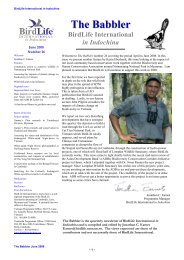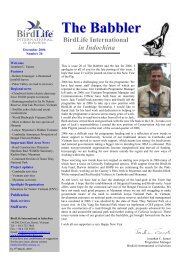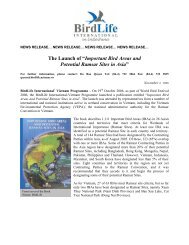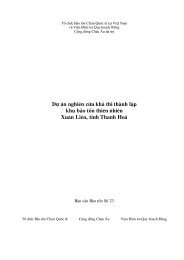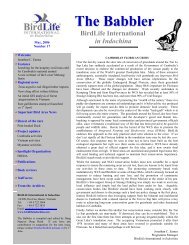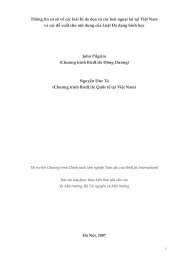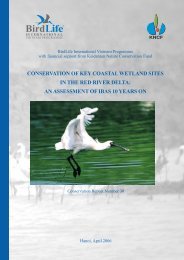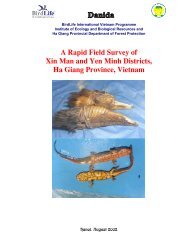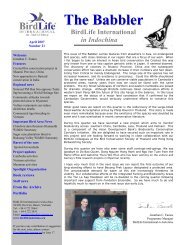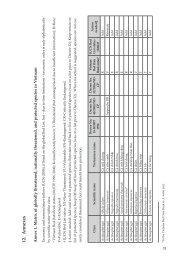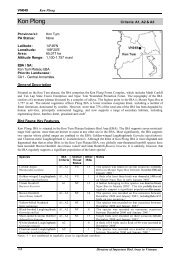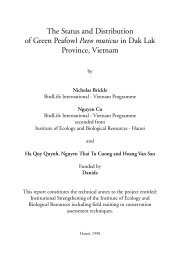A Feasibility Study for the Establishment of Xuan Lien Nature ...
A Feasibility Study for the Establishment of Xuan Lien Nature ...
A Feasibility Study for the Establishment of Xuan Lien Nature ...
Create successful ePaper yourself
Turn your PDF publications into a flip-book with our unique Google optimized e-Paper software.
3. Evaluation<br />
3.1 Criteria <strong>for</strong> Evaluating <strong>the</strong> Proposed <strong>Nature</strong> Reserve<br />
In order to evaluate <strong>the</strong> overall importance <strong>of</strong> a site, it is useful to compare <strong>the</strong> site against a set <strong>of</strong> criteria <strong>for</strong><br />
assessing a protected area’s conservation value. The study area satisfies some but not all <strong>of</strong> <strong>the</strong> criteria identified<br />
Table 13: Conservation Criteria and Evaluation <strong>of</strong> <strong>Xuan</strong> <strong>Lien</strong> Proposed <strong>Nature</strong> Reserve<br />
Conservation Criteria Site Evaluation<br />
22<br />
Size:<br />
The area must be <strong>of</strong> a size and <strong>for</strong>m sufficient to<br />
support ecological units or viable populations <strong>of</strong> flora<br />
and fauna. As a rule, conservation importance increases<br />
with protected-area size.<br />
Richness and Diversity:<br />
Usually linked with <strong>the</strong> diversity <strong>of</strong> habitat types;<br />
ecological gradients or ecotones should be represented<br />
because <strong>the</strong>y support transitional communities.<br />
Naturalness:<br />
Assessment <strong>of</strong> <strong>the</strong> extent <strong>of</strong> primary habitats.<br />
Rarity:<br />
The primary purpose <strong>of</strong> many protected areas is to<br />
protect rare and endangered species and habitats.<br />
Rarity may be a result <strong>of</strong> special habitat requirements,<br />
direct human pressure or indirect human influences.<br />
Uniqueness:<br />
Areas which exhibit particular natural processes or<br />
which are poorly represented in <strong>the</strong> national protection<br />
system.<br />
Typicalness:<br />
It is important to represent typical areas <strong>of</strong> common<br />
habitats and typical communities <strong>of</strong> a biome.<br />
Fragility:<br />
A measure <strong>of</strong> an area’s susceptibility to change through<br />
ei<strong>the</strong>r natural or man-made processes.<br />
Position as an Ecological Unit:<br />
To establish <strong>the</strong> area’s position in an ecological unit, it<br />
is important to determine how or whe<strong>the</strong>r an area is<br />
linked to o<strong>the</strong>r areas <strong>of</strong> natural or semi-natural<br />
habitats.<br />
Economic Value:<br />
An area may protect a valuable water catchment or a<br />
higher level <strong>of</strong> biogeographic subdivision.<br />
Conservation Opportunity:<br />
Socio-political climate is highly determinate in <strong>the</strong><br />
success <strong>of</strong> any conservation area’s future objectives and<br />
priorities.<br />
The study area covers 23,610 ha and may not be large<br />
enough to support viable populations <strong>of</strong> certain large<br />
mammal species unless <strong>for</strong>est corridors to adjacent<br />
protected areas supporting suitable habitat are<br />
maintained.<br />
The study area has moderate levels <strong>of</strong> biodiversity<br />
relative to o<strong>the</strong>r protected areas in nor<strong>the</strong>rn and central<br />
Vietnam. An altitudinal gradient exists between 50<br />
and 1,600 m.<br />
The natural vegetation <strong>of</strong> <strong>the</strong> study area has been<br />
heavily disturbed by human activities and only 10%<br />
<strong>of</strong> <strong>the</strong> original primary <strong>for</strong>est remains.<br />
The study area protects 19 globally threatened species.<br />
Four plant and five vertebrate species are endemic to<br />
Vietnam or to Vietnam and Laos. The study area<br />
supports only two bird species listed as globally<br />
threatened.<br />
Roosevelt’s Muntjac is known globally only from <strong>the</strong><br />
study area and one o<strong>the</strong>r site in Laos.<br />
The study area contains representative examples <strong>of</strong><br />
sub-montane dry evergreen <strong>for</strong>est and lowland semievergreen<br />
rain<strong>for</strong>est, <strong>the</strong> two most widespread natural<br />
habitat types in Vietnam.<br />
22% <strong>of</strong> <strong>the</strong> study area is covered by regenerating <strong>for</strong>est.<br />
To <strong>the</strong> south, <strong>the</strong> study area is contiguous with Pu<br />
Hoat proposed nature reserve, <strong>for</strong>ming a combined<br />
conservation area <strong>of</strong> 90,841 ha.<br />
The study area protects <strong>the</strong> water catchment <strong>of</strong> <strong>the</strong><br />
Chu River and <strong>the</strong> planned Cua Dat dam.<br />
The proposed nature reserve has good political support<br />
at <strong>the</strong> provincial level. Following <strong>the</strong> construction <strong>of</strong><br />
Cua Dat dam, <strong>the</strong>re will be no human settlements in<br />
<strong>the</strong> study area.




